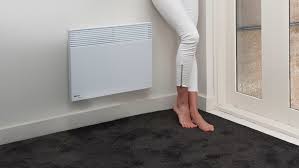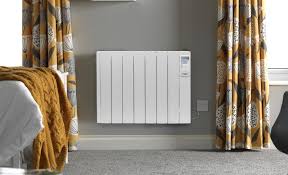What is a Panel Heater?
A panel heater is a type of electric heater that you can mount on the wall. You can put panel heaters anywhere you like, as long as there is a 30cm clearance at the top and bottom of the panel to allow for the convection current and a nearby power socket. As panel heaters are usually IP22 waterproof, you can also use them in the kitchen and bathroom with complete confidence.
Panel heaters are a popular choice due to their slim design and fast acting heat. They work particularly well in smaller spaces or spaces you use infrequently as they provide instant heat as soon as they are switched on meaning that you don’t have to wait around before you can comfortably use the room.

How the panel heater works – Natural convection technology
Econo-Heat wall panel heaters offer out-of-the-way wall mounting and are an economic way of providing efficient room heating at a low cost. Using natural convection technology, heat is mainly generated behind the heater in the space between the panel and the wall, which leads to an efficient up draught of heated air circulated into the room (the heated air rises at a speed of 0.7m per second!). This principle of convection means that about 90% of the heat comes from the back of the panel, while only 10% is radiated from the front of the panel. This form of background heating is extremely economical, safe and efficient.
Your Econo-Heat wall panel heater is designed as an alternative to conventional bar heaters and other forms of high output heaters that use large amounts of electricity. It operates at relatively low surface temperatures (75 – 90°C, dependent on the ambient temperature), and uses minimal electricity.

Benefits of Electric Heating
Electric is the fuel of the future for heating requirements. With volatile oil prices and supplies, less and less natural gas and more renewable electricity production, heating your home with an electric heating system will future proof your property Dwindling supplies of north sea gas, the uncertainty of imported gas supplies, the volatility of oil prices and the commitment to reduce the U.K. carbon footprint all point towards electricity as the fuel of the future. The government has set a clear path towards a lower carbon future, with electricity to be generated by nuclear power and sustainable sources e.g. wind power, solar energy, wave power etc. Electric heating is 100% efficient and carbon neutral at the point of use, and with electricity being generated by nuclear and renewable sources in the future it will become completely carbon neutral. The government also promotes the use of micro generation technologies e.g solar panels, photovoltaic’s and wind turbines. Electric heating appliances are compatible with all these micro generation technologies. As more low carbon and renewable sources of electricity become available we will increasingly see electric heating being favoured over gas.
Low Installation Costs
Electric heating is very easy to install. There is no requirement for unsightly pipe work, and minimal disruption during installation. Because each electric radiator can work independently, it is easy to add to a system as necessary or as budgets permit. Also because each radiator is controlled independently from the system, it allows much better control over room temperatures and energy usage than is possible with a boiler based system.
LOW OWNERSHIP COSTS
The true ownership costs of a heating system should be looked at over a system lifetime. Electric heating systems have no moving parts and can be expected to last over 15 years. The boiler industry quotes a lifetime of 10 years for a boiler. Boiler based systems require costly yearly maintenance whereas electric systems are maintenance free. Electric heating is 100% efficient at the point of use meaning all the fuel used is turned into heat unlike boiler systems where energy is wasted through the flue. No Maintenance and no annual inspection. Yearly maintenance and safety checks can add significant costs to the running of a system. Gas boiler systems require yearly maintenance and if used within rental properties, both private and social housing landlords are responsible for annual safety inspections. This can also be a major hassle for landlords needing to gain access to properties to conduct maintenance and safety checks. Electric heating does not require any maintenance or safety inspections.

What does this mean?
Put simply the cost of buying your gas powered boiler is more than an electric heating system. So is the cost of servicing, maintenance and potential repairs. In addition, the electric heater should last 50% longer than the gas boiler! Put together, this figure will almost always cancel out the fact that gas is cheaper than electricity; electric heating is a better solution over the long term for your wallet!
Meet the Modern Electric Heater
The electric heater has evolved over the last few years. They now have sophisticated and ultra reliable thermostatic controls. These can ensure that your room temperature is kept constant whilst activating the heater only when needed. It is much easier and cheaper to keep a room warm then to let it cool and reheat it!
The array of options can be decided by you at the time of purchase. Heaters can have a plug-in control module, or they can be supplied with every imaginable feature built in. You can even control all your heaters from one programmer and link them to a smart system; enabling heating control away from home!
It is also important to consider then fact that electric heaters are generally safer. A gas or other fuel burning system will produce carbon monoxide; which is deadly and must be removed from the home. This is not an issue for the electric heater.
Indeed, if a radiator bursts or the boiler breaks it is highly likely that your heating system will be shut off. But, if one electric heater breaks; the rest will still function perfectly. There really is much more to electric heating than meets the eye!

Recent Comments